
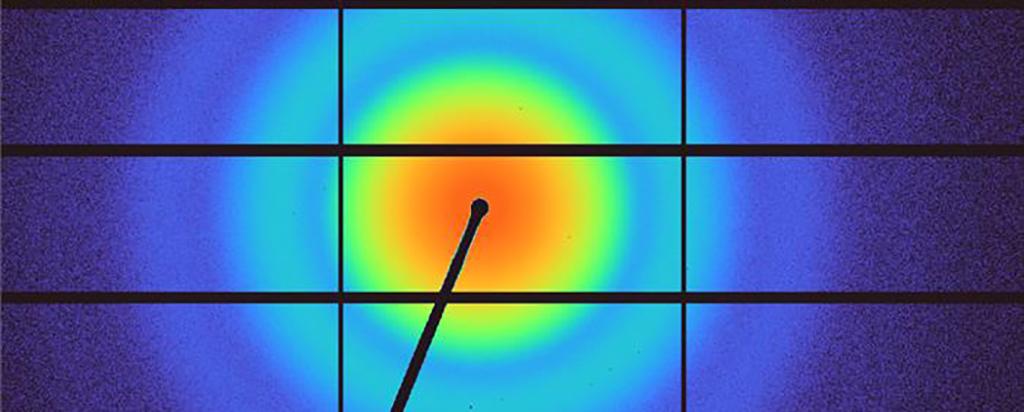
Biological small angle X-ray scattering beamline (BioSAXS)
BioSAXS is a high flux beamline dedicated to perform all types of solution small angle scattering (SAXS) experiments, with applications in biology, chemistry, material sciences, and other research fields; offering access to a variety of researchers from Australia and New Zealand.
Beamline Updates
November 2023 – User operations underway
User operations on BioSAXS commenced on October 26th 2023 with a user group from UniSA using our Linkam stage, closely followed by a group from CSIRO utilising the Peltier capillary rack.

The Coflow unit arrived at the synchrotron and is undergoing final site acceptance testing before being integrated into the beamline
August 2023 – BioSAXS end station readiness review complete
In August 2023, the BioSAXS Pilatus 2M detector was installed in the vacuum vessel and final testing for readiness review was completed.
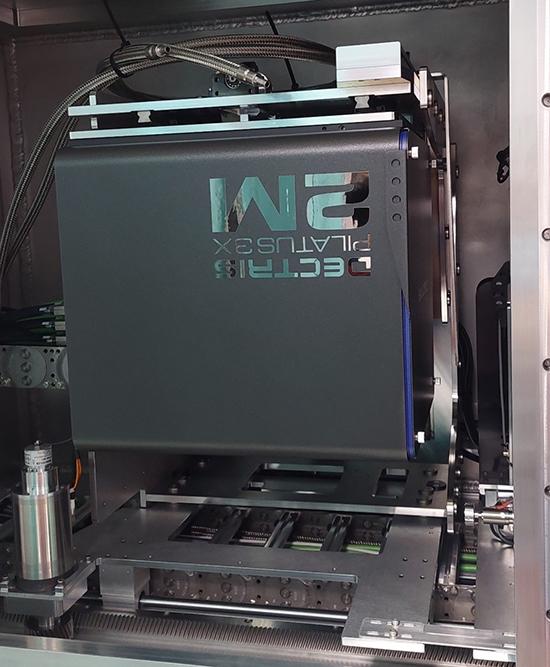
The first image on the BioSAXS detector was recorded on the eve of the August shutdown, ready for hot commissioning in 2023 cycle 3.
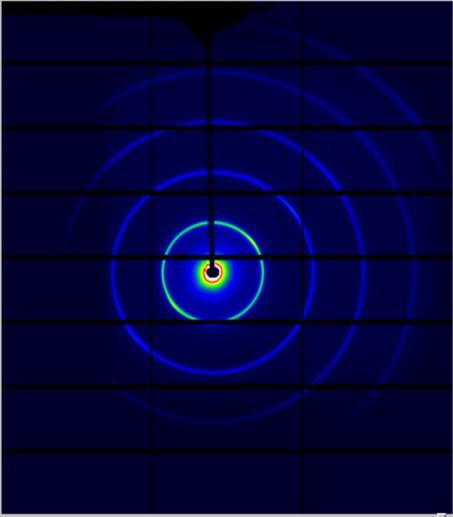
July 2023 – BioSAXS approaching user operations
Many milestones have been achieved on BioSAXS over the last 12 months, all of which has led to BioSAXS being poised to enter user operations in 2023 cycle 3.
In August 2022, the vacuum vessel that houses the BioSAXS detector was installed in the experimental hutch after passing its factory acceptance tests at the local supplier in Melbourne. Following installation works, the site acceptance tests for the vessel were completed a few weeks later, certifying the vessel ready for operations.
Shortly after this in September 2022, the superconducting undulator was installed in the synchrotron storage ring, giving the beamline its light source.
Following approval by ARPANSA to commence taking beam, first light on BioSAXS was achieved in late November 2022, about a week before the Christmas-New Year shutdown – making for an early festive gift for the project team.
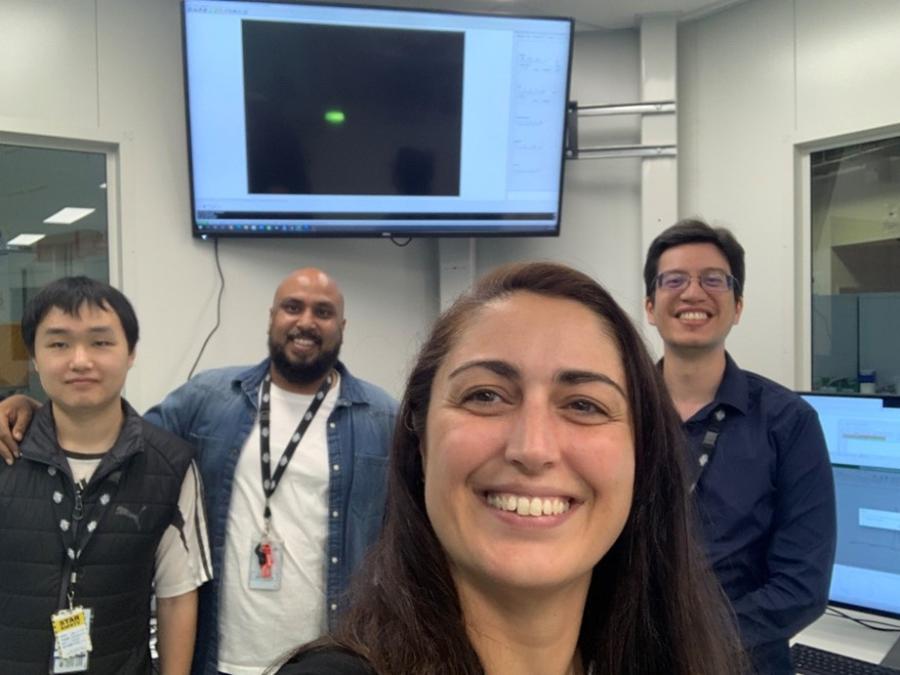
In the new year, work began in earnest on hot commissioning the photon delivery system of the beamline, threading the beam through the beamline optics used to generate a focussed beam of well-defined X-ray energy.
September 2021 - Good progress on BioSAXS despite lockdown challenges
Despite the many challenges brought by the COVID-19 pandemic and subsequent lockdowns, individuals and organisations are managing to make progress on important projects.
The addition of six new beamlines as part of Project Bright at the Australian Synchrotron was impacted shortly after work had started on the many stages needed to order and install the new technology.
Lead scientist on the BioSAXS beamline, Dr Christina Kamma-Lorger remains optimistic that new instrument will be operational by the second half of next year.
An issue arose this year when chaos in the Port of Singapore impacted by the blockage in the Suez Canal, caused some early delays. The lead shielding was transported to Australia by ship from Innospec Prüfsystem GmbH (Dresden, Germany).
“The first components, protective shielding for the instrument, started arriving in mid-August. A supervising technician from the vendor who supplied them went into quarantine, while our team started assembling the structure,” said Kamma-Lorger.
Hutch A, a teal-coloured rectangular container, is now assembled with work on Hutch B underway.
“The instruments around the new beamline are very sensitive to vibrations, so that called for extra care with the positioning work,” she said.
The next step after Hutch B is assembled is the installation of utilities, possibly by late November.
Subsequent work will involve the addition of the user cabin and photon delivery system.
“The very last stage is the installation of the insertion device in the storage ring,” said Kamma-Lorger.
She added that the great effort by internal engineering, computing and technical teams, in collaboration with local and overseas vendors, has driven progress on the installation of the 40-metre beamline.
“After the instrument is commissioned next year, our users will have access to a high-flux beamline that can be used to study chemical and biological systems at the nanoscale.
“Even samples that are highly sensitive to radiation can be studied using the CoFlow sample environment developed at the Australian Synchrotron,” she added.
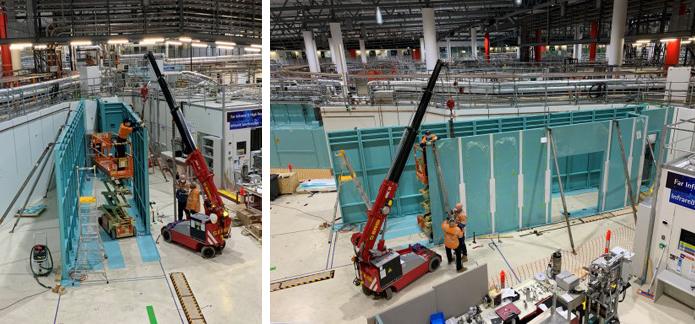
Capability Summary and Techniques
The BioSAXS Beamline enables the study of nanoscale chemical and biological systems in solution, including surfactant and lipid mesophase systems, proteins and protein complexes.
BioSAXS allows highly radiation-sensitive samples to be studied using unprecedented levels of flux. This is achieved using the CoFlow sample environment, developed at the Australian Synchrotron. The beamline offers high-throughput and excellent data quality, for all liquid phase scattering experiments, allowing measurement of new and novel samples, and experiments that otherwise would not be possible. The BioSAXS beamline aims to accommodate most solution SAXS experiments for a wide range of particle sizes (up to several hundred nm) by offering a q-range of ~ 0.001 – 3 Å-1, with low instrument background and an optical design optimized for high flux X-rays (1014 ph/s).
To achieve this, the beamline consists of a superconducting undulator (SCU) insertion device, a double multilayer monochromator, as well as vertical and horizontal beam-focusing mirrors. The beamline maintains the flexibility to allow a wide range of optical configurations. For the purposes of controlling dose (minimising radiation damage), the beamline primarily collects data in a vertically unfocussed mode, offering a beamsize of 0.3 mm (H) x 0.8 mm (V). If needed, it will be able to achieve a focused beam size of 0.3 mm (H) x 0.03 mm (V). The beamline also focuses on a variety of dedicated high-quality sample environments offering high throughput data collection, and systems for automatic processing and analysis of data.

The BioSAXS endstation including in vacuum SAXS detector system and sample table
Sample environments up to 100 kg can be accommodated on a 750 × 400 mm2 sample table with a wide range of automated motion for easy alignment. Options will be made available for rheometry, microfluidics, temperature control with multiple sample positions and application of external magnetic fields, allowing for automated, high-throughput in-situ studies of liquid phase systems. The BioSAXS beamline is built with a high degree of versatility at the sample position, and users are strongly encouraged to discuss their own custom in-situ experiment set-ups with the BioSAXS team.
Data is acquired with an automated in-vacuum detector system, allowing for versatile and rapid change of SAXS camera length. A wide Q-range can be covered easily and quickly by changing camera length, as the detector can traverse the full length of the vacuum vessel in just a few minutes. A fast detector is being used to provide time resolution on the scale of milliseconds, which can be used to study sample dynamics.

The BioSAXS endstation including in vacuum SAXS detector system and sample table
BioSAXS Core Capabilities
- Low scatter/low concentration protein samples with automated sample changer (CoFlow) for batch measurements
- In-line size exclusion chromatography (SEC) coupled to CoFlow
- Time-resolved experiments studying chemical reactions, protein interactions, etc. using a stopped-flow device (Available mid 2026)
- Particle alignment experiments with a shearing cell (Available late 2026)
- Linkam capillary cell for temperature variation studies
- Static capillary measurements in a temperature-controlled capillary rack
- Magnetic arrays for studying ferrofluids/magnetic nanoparticles (Available 2027)
Scientific Applications
BioSAXS will perform a wide variety of solution and soft matter Small Angle X-ray Scattering (SAXS) experiments and will cover a wide range of disciplines ranging from biology to chemistry and material sciences. Examples include:
Macromolecular biological structures and protein folding
- Low resolution protein structure and folding can be studied using SAXS. Unlike protein studies using crystallography, protein studies in solution are a dynamic systems that permits changes in the conditions in situ and the investigation of structural changes in proteins in real time. This is of great importance in the field of biomedicine and the study of various diseases such as Alzheimer’s, heart disease, and cancer etc, as well as in the design of new pharmaceutical agents
- Time-resolved experiments of protein-protein interactions, as well as nucleic acid-protein interactions and enzymatic reactions are key for understanding of biological processes, as well as the development of new therapeutic approaches in a variety of diseases
Soft matter
- Surfactants have a wide range of applications, particularly in the formation of liposomes, micelles and other structures with applications in drug delivery and nanomedicine. These assemblies have features on multiple length-scales that can be observed using SAXS, from surface ordering in surfactant bilayers to the overall structures of liposome materials
- Amphiphilic block copolymers tend to self-assemble in different solvents, depending on a range of parameters including temperature, concentration, pH and solvent choice. These can sometimes form polymer micelles, which have potential applications in drug delivery systems, and nanomedicine, as smart switching enables controlled uptake and release. The structure and assembly dynamics of these systems can be studied in-situ with SAXS
- Amphiphilic lipids can also form highly structured liquid crystalline matrices in the presence of surfactants and nanoparticles, offering a wide range of applications such as photocatalytic and photothermal conversions as well as drug delivery and release strategies. Near infrared exposure can trigger changes in lipid packing and phase that can be studied in situ on a dynamic fashion using SAXS. Lipids also form the fundamental building block of our cellular membranes, the structure and function of which can be studied using SAXS
- Liposome structure optimisation and ability to carry medicinal agents can also be studied using SAXS. This area is of particular interest in the field of drug delivery
Shear, flow and microfluidics
- Understanding the mechanical response of colloidal fluids is important in a number of areas including food science, polymers, and materials science. The viscosity of a colloidal suspension is strongly dependent on numerous parameters, including the size and flexibility of the constituent particles. Rheo-SAXS can be used to simultaneously observe flow-induced orientational ordering and its influence on the viscosity and rheology of the system
- Rapid kinetics of numerous systems (particularly colloids and self-assembling surfactants) can be studied using the stopped-flow apparatus with SAXS. As acquisition can be synchronized with the mixing process, formation reactions can be studied on millisecond time scales, along with sample responses to rapid “jumps” in temperature, pH or dilution
- Microfluidics can be used to study the flow response of complex fluids, especially solutions and colloids that are non-Newtonian. Microfluidics with SAXS can generate nanoscale structural information of systems under flow, including dilute polymer solutions, surfactant solutions, microemulsions and lipid bilayers
- Shear flow sample environment would permit the study of tubulin structure and assembly capabilities under normal and diseased conditions as well as the effect of medicinal agents in tubulin assembly. This type of studies have an important role in biomedicine and the development of antitumor drugs that modulate protein dynamics
Nanoparticles and aggregations
- Interparticle interactions between surface coated nanoparticles can be understood with SAXS, as complex aggregate structures can be observed on multiple length-scales depending on whether the surfactants are attractive or repulsive
- Dilute dispersions of magnetic nanoparticles with complex shapes (e.g., dumbbells, stars or nanoflowers) or core-shell structures have immense potential in biomedical applications, such as magnetic drug delivery and/or magnetic hyperthermia (the delivery of heat to a cancer tumour via targeted magnetic nanoparticles). SAXS can provide high-resolution measurements of the particle form-factors (including size and shape) and can be used to study ordered long-range structures induced upon application of magnetic fields
Technical Information and Specifications
BioSAXS is designed to deliver a high brilliance beam at sample position. The beamline will operate on a fully focused, partially focused or unfocused beam mode in order to control dose and radiation damage at samples.
Technical Specifications
View BioSAXS Technical Specifications
| Energy range | 8-15 keV | |
|---|---|---|
| Bandwidth (ΔE/E) | 1 % | |
| Source | Type | Superconducting Undulator (SCU) |
| No of periods | 98 | |
| Period | 16 mm | |
| Optics | ||
| DMM | B4C/Mo multilayers on silicon substrates, multilayer periodicity = 25 ± 1 Å | |
| VFM and HFM | Rh coating for reflectivity | |
| Beam characteristics at sample position | Beam size | 300 x 800 µm2 (un-focused beam) 300 x 30 µm2 (fully focused beam) |
| Flux | >1014 ph/sec at 200 mA at 12.4 keV | |
| Endstation | In vacuum 8 m vessel | |
| Detector | Pilatus3X-2M detector in an in-vacuum movable detector system 172 µm2 pixel size 25 Hz frame rate | |
| Q-range (expected at 12.4 keV) | 0.0013-4 Å -1 |
Beamline status
View Beamline status
Current status: BioSAXS received the first users with the Linkam and multicapillary stages. CoFlow is currently in the commissioning stage and the next sample environment to be deployed in December 2023.
| Date | Status |
| 2018 April | Investment case was approved |
| 2019 March | Conceptual Design Report completed |
| 2019 December | Tender submitted for superconducting undulator insertion device |
| 2020 February | Tender submitted for the BioSAXS radiation enclosures (hutches) |
| 2020 March | Tender submitted for the Photon Delivery System (PDS) |
| 2020 April | Superconducting undulator tender awarded to Billfinger |
| 2020 June | BioSAXS photon delivery system tender awarded to FMB Oxford |
| *2020 | BioSAXS radiation enclosures (hutches) tender to be awarded |
| *2020 | BioSAXS end station to be purchased |
| *2021 | BioSAXS radiation enclosures (hutches) to be installed |
| *2021 | BioSAXS endstation to be installed |
| *2022 February | Photon delivery system installed and beamline cold commissioning begins |
| 2022 August | Vacuum vessel installed in experimental hutch |
| 2022 September | Superconducting undulator installed in the synchrotron storage ring |
| 2022 November | ARPANSA approval for operations received and first light on BioSAXS observed |
| 2023 Febuary | Photon Delivery System hot commissioning and endstation cold commissioning |
| 2023 August | Photon Delivery System hot commissioning and endstation cold commissioning |
| 2023 October | First User Experiments; Beamline fully commissioned over the next 12 months |
| 2023 November | Coflow arrives on site and commissioning begins on BioSAXS |
* Some delays due to covid-19 are possible but not built into the schedule at this time
Beamline layout
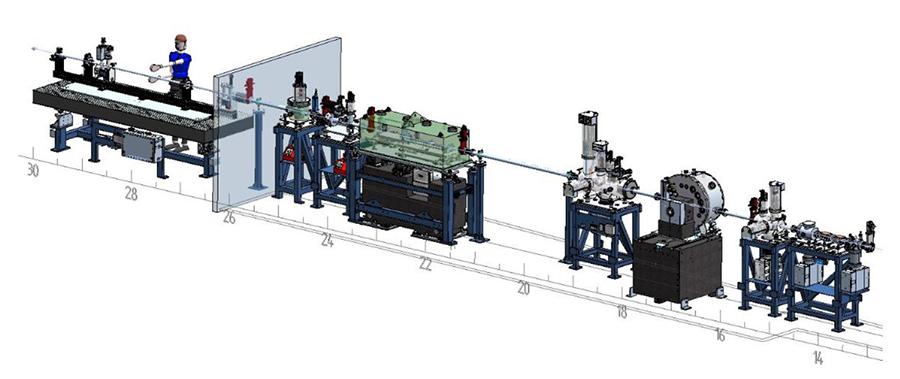
Schematic of the BioSAXS photon delivery system (courtesy of FMB Oxford)
Further technical details about the BioSAXS beamline and the available sample environments can be found on the Beamline Wiki.
Guidelines for choosing the right beamline
- Contact staff at [email protected] for guidance on specific experiment plans and beamline suitability
For up to date guidance on whether BioSAXS is the appropriate beamline for your experiemnt, please refer to the Proposal Preparation Guidelines page of the beamline wiki.
Find out more on the BioSAXS Beamline User WikiView the Wiki
Staff
- Dr Andrew Clulow – Senior Beamline Scientist
- Dr Lester Barnsley – Beamline Scientist
- Dr Annmaree Warrender – Beamline Scientist
- Mr Gonzalo Conesa-Zamora – Project Manager
- Mr Sudharshan Venkatesan – Lead Engineer
- Mr Zhaolin Liu – Controls Engineer
- Mr Taran Batty – Controls Engineer
- Mr Clinton Roy – Senior Scientific Software Engineer
- Ms Christina Magoulas – Senior Scientific Software Engineer
Former Staff
Dr Christina Kamma-Lorger – Lead Beamline Scientist (2018-2023), currently at FOS Consulting Services
Beamline Advisory Panel
- A/Prof. Duncan McGillivray (Chair) – Auckland University, New Zealand
- Dr Javier Perez - Soleil Synchrotron, France
- Dr Lachlan Casey – University of Queensland
- A/Prof. James Murphy - Walter+Eliza Hall Institute of Medical Research, Victoria
- Dr Ann Kwan - University of Sydney
- Dr Tim Ryan – ANSTO
- Prof. Ben Boyd – Monash University
- A/Prof. Tamar Greaves – RMIT University